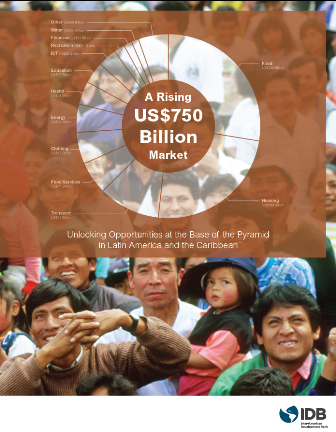Using national household and expenditure surveys, the study presents data on the BOP market size, socioeconomic characteristics, market segments, expenditure patterns, and demand-related factors. It also provides insights into what the region's BOP consumers want and identifies underserved markets and business opportunities.
The report does not limit itself to data analysis, though. It also examines the supply side of BOP markets and analyzes what types of business models, distribution channels, and input sources have enabled enterprises to successfully engage the BOP market in the region.
Some key takeaways in terms of data:
- The BOP market in Latin America and the Caribbean is made up of households whose members earn up to US$10 purchasing power parity (PPP) per capita per day in 2005 dollars, and it accounts for about 70 percent of the region’s population, or 405 million people.
- The Latin American and Caribbean BOP is mostly urban, with three-quarters of BOP households in urban areas having access to basic services such as water and electricity.
- The region's BOP market is made up of two segments: the poor, living on up to US$4 PPP per capita per day in 2005 U.S. dollars, and the vulnerable, living on US$4 to US$10 PPP per capita per day in 2005 U.S. dollars. Poor households are defined as those without sufficient resources or abilities to meet their current needs, while vulnerable households are defined as being able to meet some needs but still at risk of sliding back to poverty in the future. A significant share of the BOP still lives in poverty (45 percent), but overall, BOP households are finally reaping the benefits of a more stable economic environment and a period of high economic growth.
- With average per capita income of US$1,873 PPP, the overall size of Latin America and the Caribbean’s BOP market is US$759 billion PPP, representing about 10 percent of the regional economy.
- The image below depicts the market size by economic sector, in billions of US$ PPP, highlighting the importance of the food, housing, and transport sectors.
Through this report, OMJ also gets across its core message that market opportunities at the BOP in the region are “far more promising than ever before. This report challenges misperceptions of the BOP as a monolithic bloc of low-income people who lack the purchasing power to be a profitable market for business investments. On the contrary, Latin American and the Caribbean BOP consumers today are more urban, more connected, more educated and have more disposable income than ever before.”
More information
- The study can be downloaded here in both English and Spanish.
- I also recommend clicking through this slide show (in Spanish only, but mostly self-explanatory data) used at the report’s launch during the recent BASE III Forum in Mexico City organized by the IDB. The Forum brought together some 1,000 representatives from leading companies, financial institutions, impact investors, opinion leaders, media, and academics from 35 countries. Watch this space in the coming days for a wrap-up of the BASE III Forum.
- For more BOP market analysis (incl. on other regions of the world), see our post on the Global Consumption Database, launched last year by the World Bank Group in 2014


